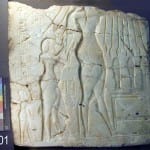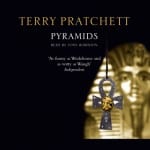Egypt on the Page: The Changing faces of Religion
By Edmund Connolly, on 6 December 2013
The ever popular and ever sold out (although some tickets left for the 13th December screening) Petrie Film club chronicles the application of Egypt in just some of the many cinematic and TV masterpieces that have turned to pyramids, mummies and anthropomorphic deities for their stimuli. Moving pictures are all very well, but I am a bookish type and prefer the idea of lounging by a fire with some sort of paged item, reading away. Terry Pratchett’s Pyramids certainly struck a chord with me, considering it in relation to the Petrie Collection and the concept of Ancient Egyptian religion and the changes it underwent.
I should probably say: Spoiler Alerts
I am aware there are many stalwart Pratchett fans out there, and I have read a meagre 5 of his epic corpus, so will not shoot myself in the foot by trying to summarise him too much. Pyramids is the same age as myself, published in 1989 and an early work of the Discworld series. Pratchett queries what would happen if all Ancient Egyptian beliefs simultaneously became real? In this deity melange the sun is pushed across the sky by a scarab, it is also worn on the crown of a rainbow coloured hawk, it is also driven across the sky by a flaming chariot. The plot revolves around this esoteric conundrum: what if the Ancient Egyptian religions were a reality, and changed as fluidly as the peoples’ belief, how would society cope?

UC401, Petrie Museum of Egyptian Archaeology. Akhenaten, his wife and perhaps children worship the Sun disk, Aten
This is especially pertinent for the Petrie due to our holdings of Armana material relating to King Akhenaten and his wife, Nefertiti. Akhenaten tried to radically change Ancient Egyptian faith to a worship of Aten , the sun, as one deity, disregarding the polytheism of his ancestors and even his father, Amhenhotep III, whose rather exuberant building works left Egypt scattered with beautiful and deity orientated monuments. However it was not just in temples that religion was found, popular deities like Sekhmet (lion headed killing / protective type, nasty when angry, nice when placated or drunk (http://escholarship.org/uc/item/2vh551hn?query=myth%20heavenly%20cow ) and Bes could have followers in private houses, away from the pomp and majesty of monumental architecture (edit1 9/12/13) . Akhenaten was by no means the only King to instigate a religious change, although around 1,500 Egyptian deities are known, not all are active at the same time, and gods assimilated one another, fluidly changing identity and meaning across the ages (Wilkinson, R. 2003, 6 -7).
Looking at the material finds, I find myself disagreeing with the idea that Akhenaten’s new faith would have changed life for the quotidian Ancient Egyptian. Akhenaten’s religion change would by no means mean that the lives of the slaves working on the pyramids, or the farmers in the fields would be all that different. This is evident in finds from the site of Amarna (Akhenaten’s city dedicated to the sun deity) from the workmen’s village depict the gods that were supposedly redundant.
This wooden stela depicts a kneeling figure before the God Wepwawet, he may look like Anubis but has a wolf’s head, rather than a jackal’s, linked to war and is known as the opener of ways.
In addition, finds from the stone village, also at Armarna depict the crocodile-hippo goddess Taweret and the impish Bes. Clearly there was not the religious overhaul that Akhenaten may have wished to implicate. Pratchett seems to be pretty accurate in his comic take on Dynastic Egypt, multiple Gods coincided and beliefs fluctuated across time, with no one faith necessarily replacing another, well done!
 Edmund works at the Petrie Museum of Egyptian Archaeology as the Projects Coordinator. He graduated from the Institute of Archaeology, UCL, in 2012 and plays sport for UCL almuni and ULU.
Edmund works at the Petrie Museum of Egyptian Archaeology as the Projects Coordinator. He graduated from the Institute of Archaeology, UCL, in 2012 and plays sport for UCL almuni and ULU.
 Close
Close



